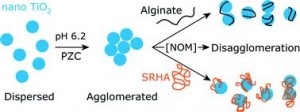One of our recent Environmental Science: Nano papers looks into the effect of natural organic matter on the disagglomeration of manufactured TiO2 nanoparticles.
This research, conducted by Frédéric Loosli and colleagues from the University of Geneva, studied the stability of TiO2 nanoparticles at various pH values.
TiO2 nanoparticles (the most produced nanoparticles to date) are used in consumer goods such as cosmetics, paints and as a UV protection agent. These consumer goods are then released into our environment, but there is a lack of data on nanomaterial transformations under relevant environmental conditions.
It is generally assumed that agglomerated nanoparticles are less toxic to aquatic organisms than single nanoparticles. As a given amount of nanoparticles will enter aquatic environments in an agglomerated, potentially less toxic form, the potential risk comes from natural processes which may considerably alter the stability of such agglomerated nanoparticles. Such processes have the possibility to disperse them, increasing diffusion and potential toxicity of the nanoparticles.
This study looked at the effects of two types of natural organic matter, at typical environmental concentrations, to determine if their presence induced significant disagglomeration of large submicron nanoparticle agglomerates. The natural organic matter used for this research were: Suwannee River humic acid, which can act as a pH regulator, and Alginate, which is found in the cell walls of seaweed and is commonly used in the food industry as a stabilizer and a thickening agent.
Figure 1
It was shown that the addition of natural organic material significantly modifies the stability of TiO2 nanoparticles by inducing disagglomeration. Figure 1, taken from the paper, demonstrates how alginate and Suwannee River humic acid effect the disagglomeration of agglomerated nanoparticles differently.
To find out more about this research, download your free* copy by following the link below:
Effect of natural organic matter on the disagglomeration of manufactured TiO2 nanoparticles by Frédéric Loosli, Philippe Le Coustumer and Serge Stoll DOI: 10.1039/C3EN00061C
*Access is free through a registered RSC account – click here to register











